/TEACHING
Experimental Design Practices Course (GD 303)
Michigan State University
2017-2019
At the outset of my appointment at MSU in 2014, I began working to reshape parts of the Graphic Design program to align with contemporary and emergent practices in the design disciplines, which are undergoing an immense amount of change. Part of this effort included the redesign of a course formerly known as “Design Thinking.”
The new course, “Experimental Design Practices” (EDP), which first ran in 2017, sought to introduce students to different ways of thinking about design and what it offers to society. It is also about the future of “design” and what it’s edges and contours might look like. What kind of course is a design course for the 21st century and beyond? And who should be able to participate in it? This course is an attempt at answering those questions through both its curricular structure and its openness to all majors.
EDP intended to introduce students to a number of aspects of design, and in this sense, it was somewhat of a hybrid “studio-survey” course. EDP aimed to introduce students to practices of design that might operate at the margins of the constellation of design disciplines, but might have something important to teach us when it comes to creating just and equitable futures.
Acknowledging the inherent limitations of the course, it covered (briefly, as mentioned above) three different modes/frameworks of design.
Michigan State University
2017-2019
At the outset of my appointment at MSU in 2014, I began working to reshape parts of the Graphic Design program to align with contemporary and emergent practices in the design disciplines, which are undergoing an immense amount of change. Part of this effort included the redesign of a course formerly known as “Design Thinking.”
The new course, “Experimental Design Practices” (EDP), which first ran in 2017, sought to introduce students to different ways of thinking about design and what it offers to society. It is also about the future of “design” and what it’s edges and contours might look like. What kind of course is a design course for the 21st century and beyond? And who should be able to participate in it? This course is an attempt at answering those questions through both its curricular structure and its openness to all majors.
EDP intended to introduce students to a number of aspects of design, and in this sense, it was somewhat of a hybrid “studio-survey” course. EDP aimed to introduce students to practices of design that might operate at the margins of the constellation of design disciplines, but might have something important to teach us when it comes to creating just and equitable futures.
Acknowledging the inherent limitations of the course, it covered (briefly, as mentioned above) three different modes/frameworks of design.
-
Inclusive, Universal, and Accessible Product/Service Design
-
Interrogative Design
- Speculative and Critical Design
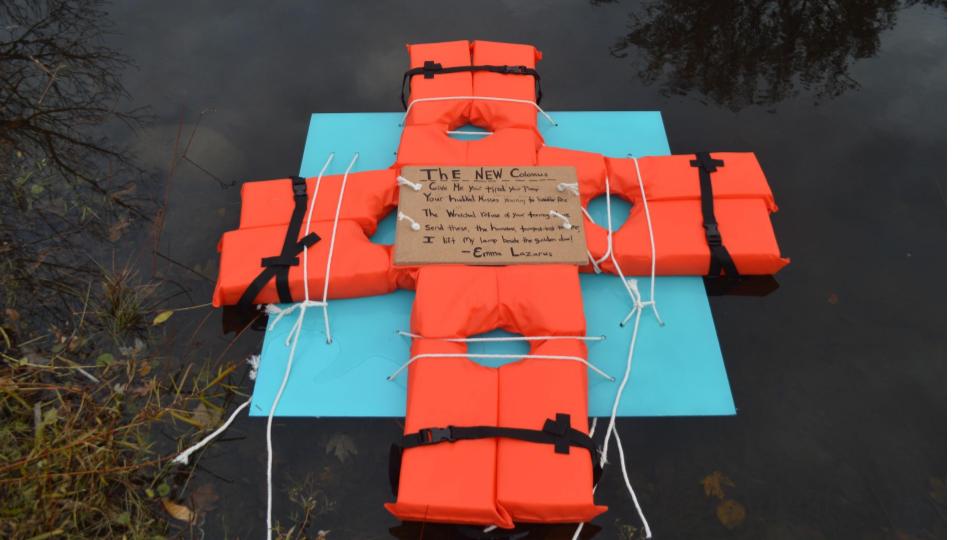
Above: Moriah Bender (BA ’18) created an intervention to raise awareness about refugees. Her project utilized the life vest as both an attractive surface as well as a symbolic object to draw viewers into conversation with her work.
Unit 1: Inclusive, Universal, and Accessible Product/Service Design
The question is not “are you disabled” but “when will you be disabled.”
– Elizabeth Guffey, Bess Williamson, Helen Armstrong, Farnaz Nickpour, 2018
The first unit, on Inclusive, Universal, and Accessible Design is probably the most familiar to students. It’s not so radically different from their understanding of what “design” is. This unit asks students to consider how “everyday life” is experienced by people who fall outside of the “norm” for which most design is created. In this project, students choose an everyday object or system and redesign it to make it more inclusive and/or accessible. What they choose to redesign and how they do so is up to them. In the end, this is an exercise in trying to think about others who are not just “users” but people, people who are different than each one of us, who have differing embodied experiences of everyday life.
To this end, the readings for this unit include Ben Highmore’s introduction to the theory of “everyday life” in the Everyday Life Reader and Lennard Davis’ “Normality, Power, and Culture,” the introduction to the Disability Studies Reader. Students also study the work of Sara Hendren and learn about the history of Universal Design and its genesis at NC State.
Students produce prototypical interventions that demonstrate their learning. Part of the project is acknowledging that the objects the students produce themselves might fail, or that they might only be a rough prototype. A polished design product is not the goal. An appreciation of a process that foregrounds inclusivity is of the highest importance.
The question is not “are you disabled” but “when will you be disabled.”
– Elizabeth Guffey, Bess Williamson, Helen Armstrong, Farnaz Nickpour, 2018
The first unit, on Inclusive, Universal, and Accessible Design is probably the most familiar to students. It’s not so radically different from their understanding of what “design” is. This unit asks students to consider how “everyday life” is experienced by people who fall outside of the “norm” for which most design is created. In this project, students choose an everyday object or system and redesign it to make it more inclusive and/or accessible. What they choose to redesign and how they do so is up to them. In the end, this is an exercise in trying to think about others who are not just “users” but people, people who are different than each one of us, who have differing embodied experiences of everyday life.
To this end, the readings for this unit include Ben Highmore’s introduction to the theory of “everyday life” in the Everyday Life Reader and Lennard Davis’ “Normality, Power, and Culture,” the introduction to the Disability Studies Reader. Students also study the work of Sara Hendren and learn about the history of Universal Design and its genesis at NC State.
Students produce prototypical interventions that demonstrate their learning. Part of the project is acknowledging that the objects the students produce themselves might fail, or that they might only be a rough prototype. A polished design product is not the goal. An appreciation of a process that foregrounds inclusivity is of the highest importance.

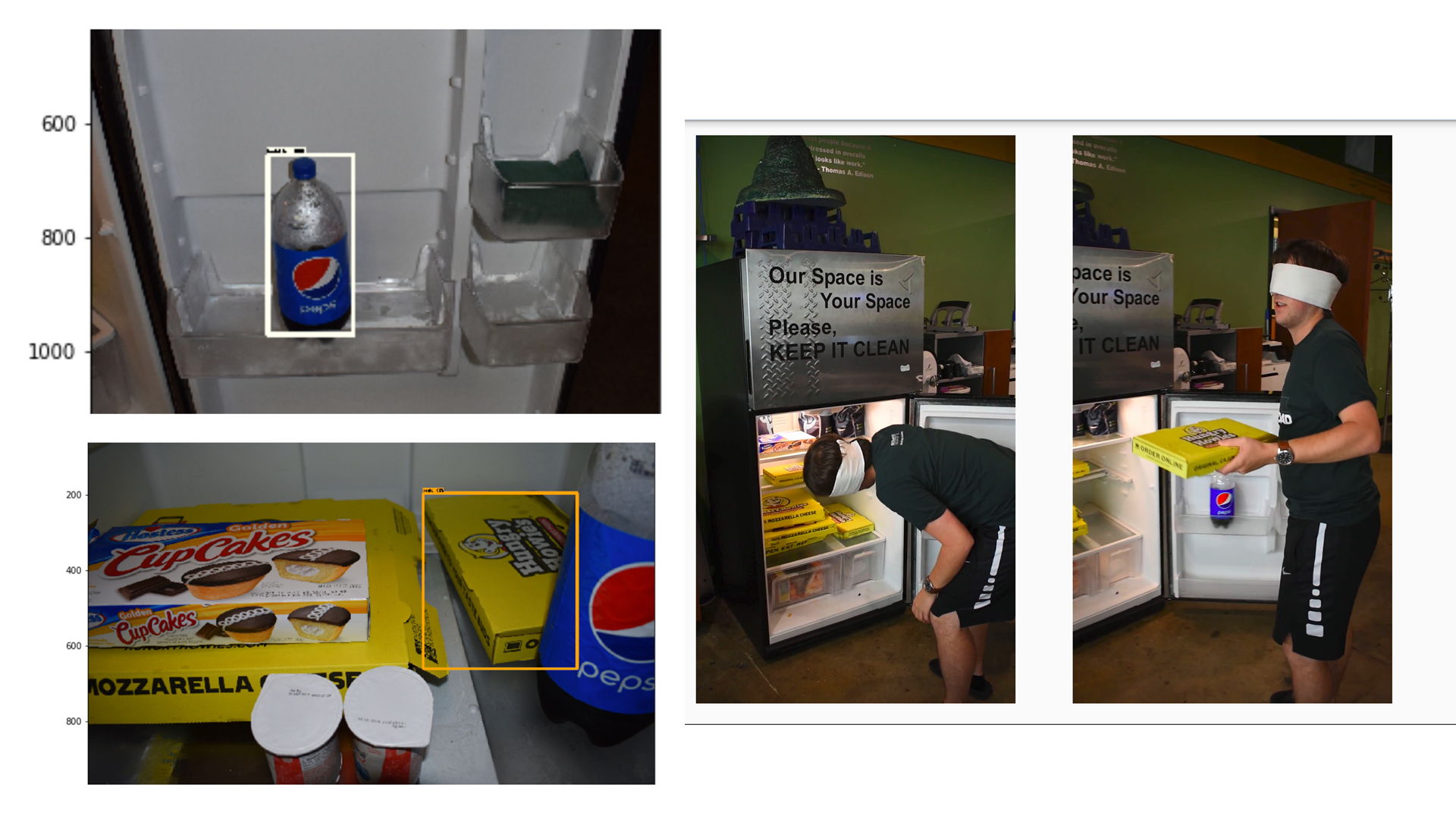
Above: Scott Swarthout (BS, Computer Science, 2018) created a concept for a combination computer-vision/voice-interaction system that would allow blind users to navigate their refrigerators through a conversational interface.
Below: Jacob Chaban (BFA, Graphic Design, 2020) worked with his grandfather to prototype an object that could help elderly users navigate stairways and hold onto railings with more ease, while accommodating different railing types.
Below: Jacob Chaban (BFA, Graphic Design, 2020) worked with his grandfather to prototype an object that could help elderly users navigate stairways and hold onto railings with more ease, while accommodating different railing types.

Unit 2: Interrogative Design
The second unit of the course is based on the work of Krzysztof Wodiczko, who termed his artistic/design practice “Interrogative Design.”
In the introduction to his monograph, Critical Vehicles, Wodiczko writes: “I attempt to detect and trace conditions of life under the illusion or delusion of freedom—the hypocritical life we lead when we take refuge in the machine of a political or cultural system while closing one eye to the implications of our own passivity or, frankly speaking, complicity… The danger lies in allowing oneself to live in something Andrzej Turowski called ideosis—the commonsense life of well-calculated choices for navigating through the system by claiming a critical or independent perspective on it. If democracy is to be a machine of hope, it must retain one strange characteristic—its wheels and cogs will need to be lubricated not with oil but with sand… My work attempts to heal the numbness that threatens the health of the democratic process by pinching and disrupting it, waking it up, and inserting the voice, experiences, and presence of those others who have been silenced, alienated, and marginalized.”
Wodiczko goes on: “In short, the critical vehicle is an “ambitious” and “responsible” medium—a person or piece of equipment—that attempts to convey ideas and emotions in the hope of transporting to each human terrain a vital judgment toward a vital change.” He suggests that his practice of “Interrogative Design” brings “critical methods and new, perhaps difficult to accept but vital, functional programs to the design of tactical equipment.” (emphasis mine)
This second project, then, asks students to produce a piece of “equipment,” a vehicle for communication, that will make visible the invisible, that will render in a new way something or someone that is marginalized or hidden because of the sociopolitical-economic structure of everyday life.
Again, the project is not intended to produce polished design outcomes but rather prototypical objects and documentation that help students appreciate a different orientation towards the role of design and its potential within society—one that does not serve to solve problems in a narrowly construed, capitalist-instrumentalist sense, but rather one that seeks to reveal that which is marginalized, invisible, or intentionally concealed.
The second unit of the course is based on the work of Krzysztof Wodiczko, who termed his artistic/design practice “Interrogative Design.”
In the introduction to his monograph, Critical Vehicles, Wodiczko writes: “I attempt to detect and trace conditions of life under the illusion or delusion of freedom—the hypocritical life we lead when we take refuge in the machine of a political or cultural system while closing one eye to the implications of our own passivity or, frankly speaking, complicity… The danger lies in allowing oneself to live in something Andrzej Turowski called ideosis—the commonsense life of well-calculated choices for navigating through the system by claiming a critical or independent perspective on it. If democracy is to be a machine of hope, it must retain one strange characteristic—its wheels and cogs will need to be lubricated not with oil but with sand… My work attempts to heal the numbness that threatens the health of the democratic process by pinching and disrupting it, waking it up, and inserting the voice, experiences, and presence of those others who have been silenced, alienated, and marginalized.”
Wodiczko goes on: “In short, the critical vehicle is an “ambitious” and “responsible” medium—a person or piece of equipment—that attempts to convey ideas and emotions in the hope of transporting to each human terrain a vital judgment toward a vital change.” He suggests that his practice of “Interrogative Design” brings “critical methods and new, perhaps difficult to accept but vital, functional programs to the design of tactical equipment.” (emphasis mine)
This second project, then, asks students to produce a piece of “equipment,” a vehicle for communication, that will make visible the invisible, that will render in a new way something or someone that is marginalized or hidden because of the sociopolitical-economic structure of everyday life.
Again, the project is not intended to produce polished design outcomes but rather prototypical objects and documentation that help students appreciate a different orientation towards the role of design and its potential within society—one that does not serve to solve problems in a narrowly construed, capitalist-instrumentalist sense, but rather one that seeks to reveal that which is marginalized, invisible, or intentionally concealed.

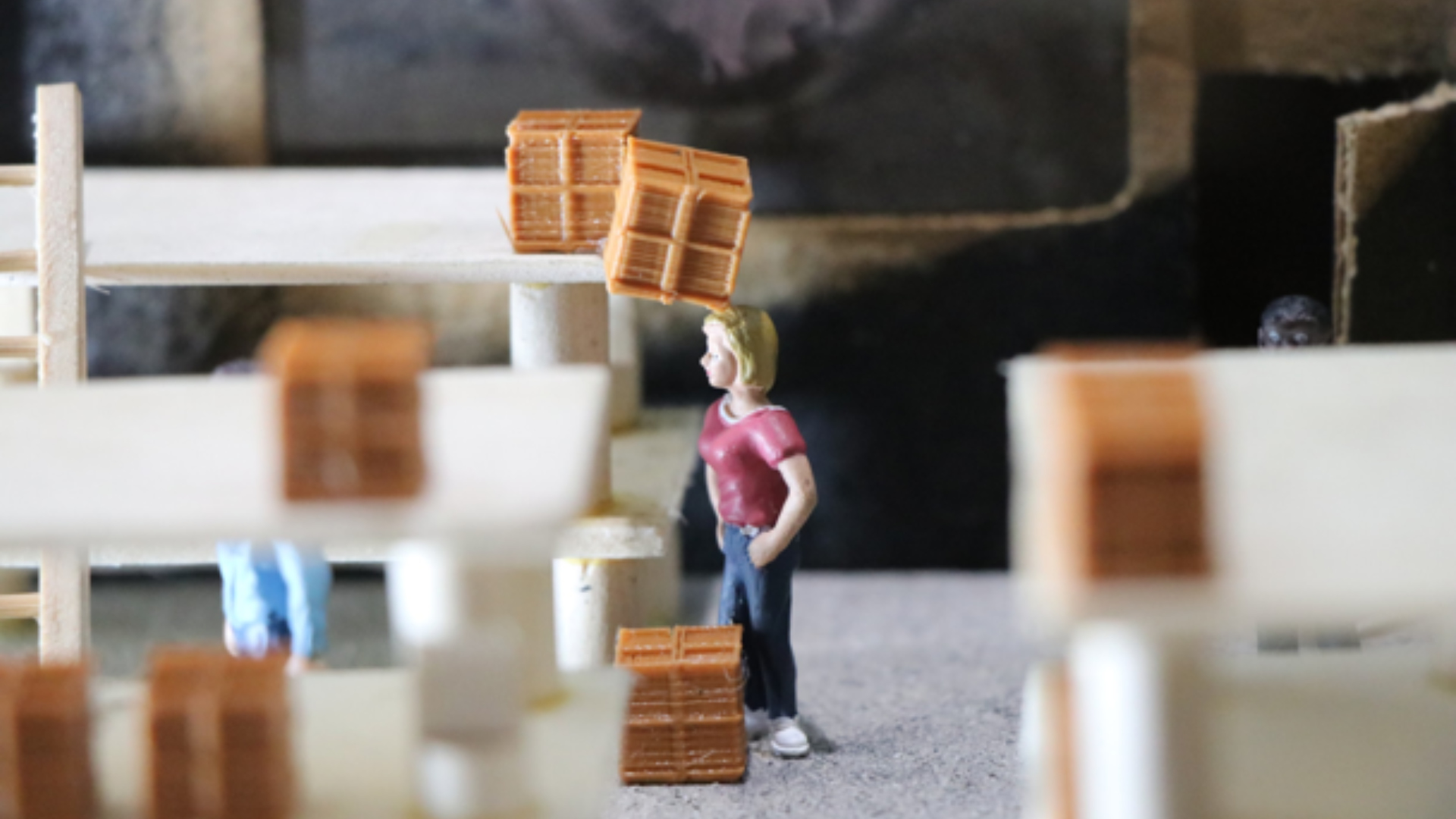
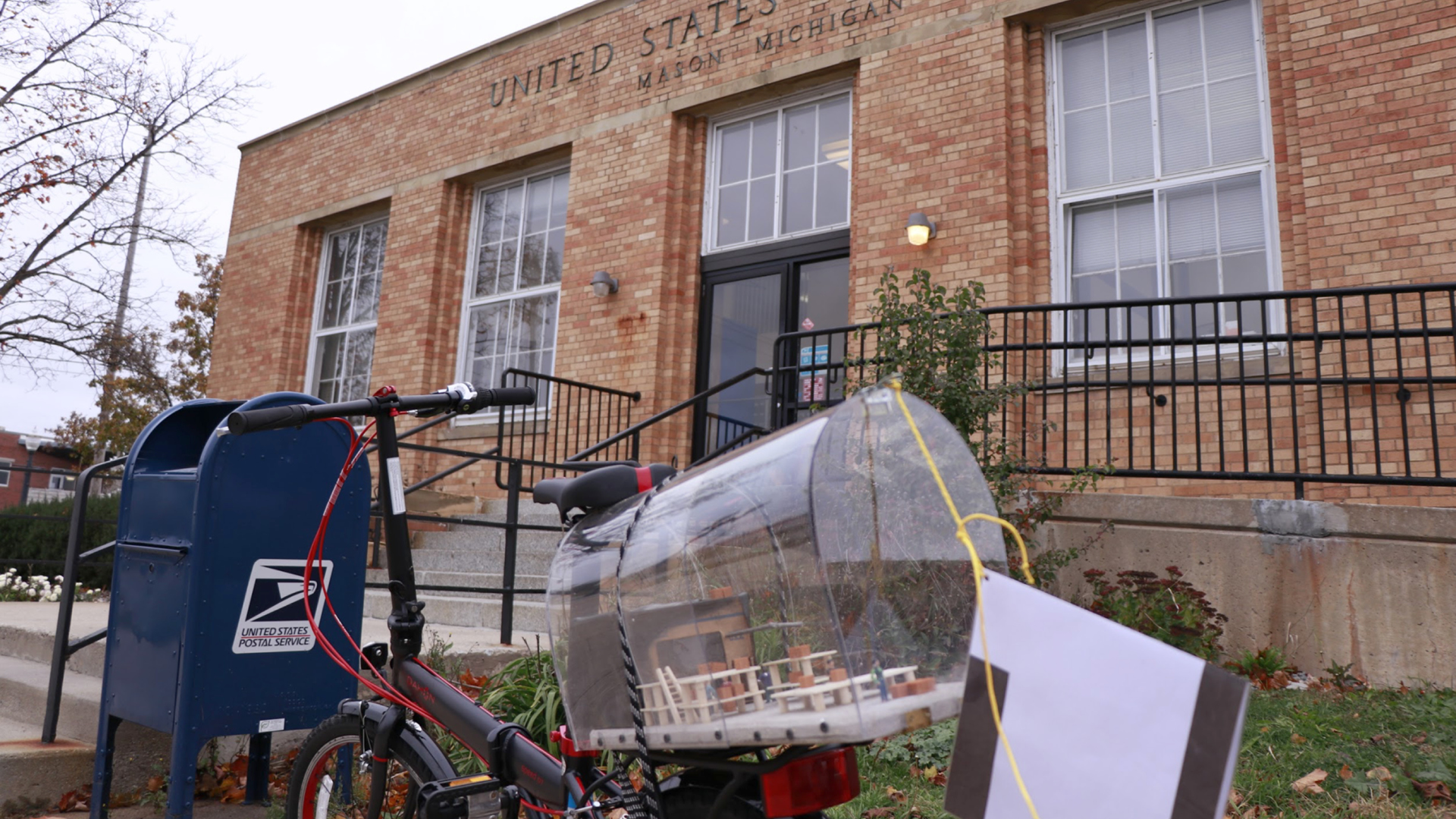
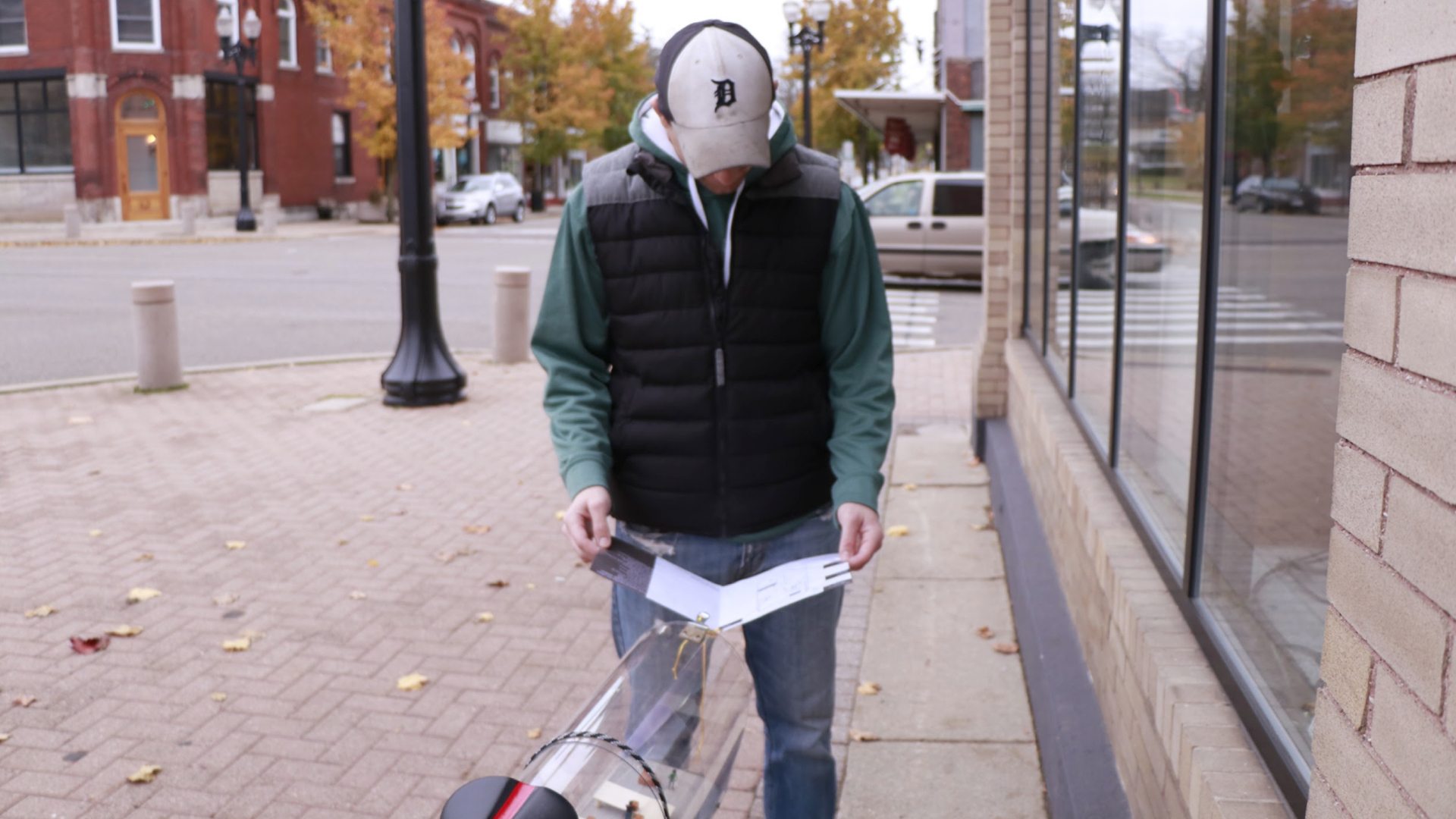
Above: Jacob Chaban created a mobile museum of workplace injuries, which is accompanied by a brochure on the increasing rate of injuries in workplaces dominated by metrics, such as Amazon’s warehouses.
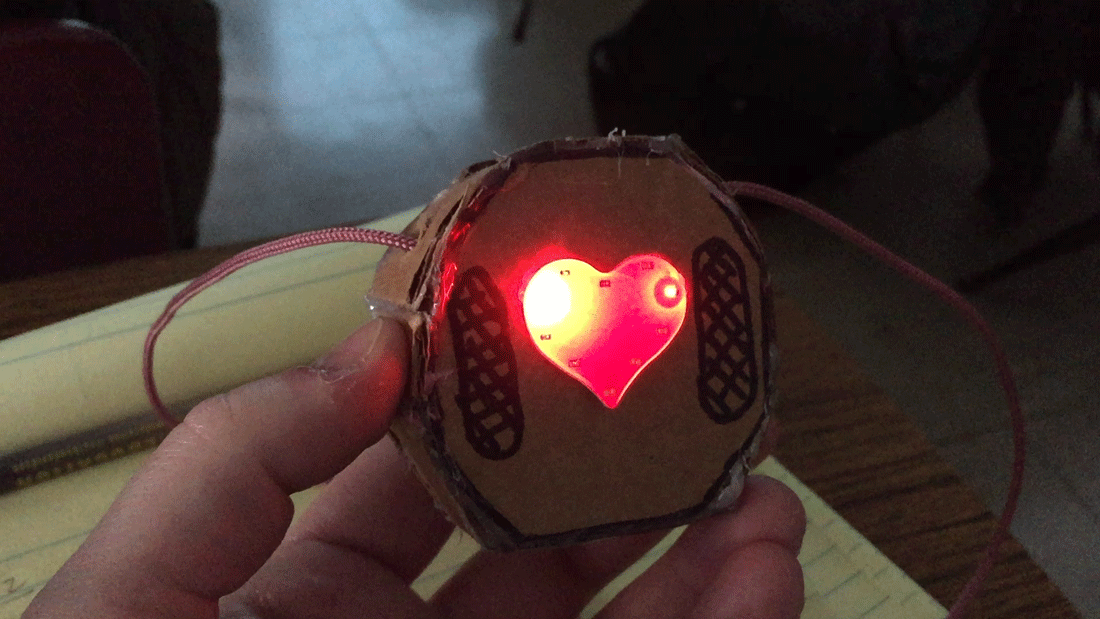

Above: Liz Vangyi’s project was beautiful and brilliant. She created a pendent intended to allow its wearer to communicate when they are experiencing a microaggression. It combines biometric feedback from the wearer with manual activation, lighting up when its wearer feels as though they are experiencing a microaggression by the person with whom they are speaking. This object then functions as a kind of mediator, its artifice drawing the aggressor into conversation with the wearer in a new way, giving the wearer an opportunity to explain what they are experiencing.

Above: Tessa Wegman (BFA ‘19) created a series of “prayer cards” that are actually about the rampant sexual abuse within the Catholic Church. She took the form of the traditional Catholic prayer card and subverted it, using her design skills to create a seductive aesthetic that draws viewers to the work.
Unit 3: Speculative/Critical Design and the Future of Everyday Life
Speculative Design is one of the more well-known and one of the more problematic branches amongst the newly codified (see UCSD’s Speculative Design undergraduate degree) forms of design practice/research. This final unit asks students to engage with a practice of examining certain sociotechnical trajectories and to speculate on them. At its very best, Speculative Design is a powerful and unique mode of questioning, interrogating, and critiquing the various futures that might emerge from the dynamic interactions of ideologies, social relations, environmental conditions, and technological innovation. Benjamin Bratton writes that “Speculative Design focuses on possibilities and potentials. It confronts an uncertain and ambiguous future and seeks to give it shape.” At its best, SD asks questions about the norms and values of societies in which its speculations would exist. In doing so, it asks us whether we might want to live in those societies, and if those values are ones by which we want to live and be governed in the future.
In this project, students produce prototypical artifacts that emerge from the development of a story about the future. This story reflects research the students do on emerging technologies and the way in which those technologies might be situated within certain political-economic regimes. Students therefore consider the physical and ideological landscape within which the technologies on which they speculate are situated.
Unit 3: Speculative/Critical Design and the Future of Everyday Life
Speculative Design is one of the more well-known and one of the more problematic branches amongst the newly codified (see UCSD’s Speculative Design undergraduate degree) forms of design practice/research. This final unit asks students to engage with a practice of examining certain sociotechnical trajectories and to speculate on them. At its very best, Speculative Design is a powerful and unique mode of questioning, interrogating, and critiquing the various futures that might emerge from the dynamic interactions of ideologies, social relations, environmental conditions, and technological innovation. Benjamin Bratton writes that “Speculative Design focuses on possibilities and potentials. It confronts an uncertain and ambiguous future and seeks to give it shape.” At its best, SD asks questions about the norms and values of societies in which its speculations would exist. In doing so, it asks us whether we might want to live in those societies, and if those values are ones by which we want to live and be governed in the future.
In this project, students produce prototypical artifacts that emerge from the development of a story about the future. This story reflects research the students do on emerging technologies and the way in which those technologies might be situated within certain political-economic regimes. Students therefore consider the physical and ideological landscape within which the technologies on which they speculate are situated.
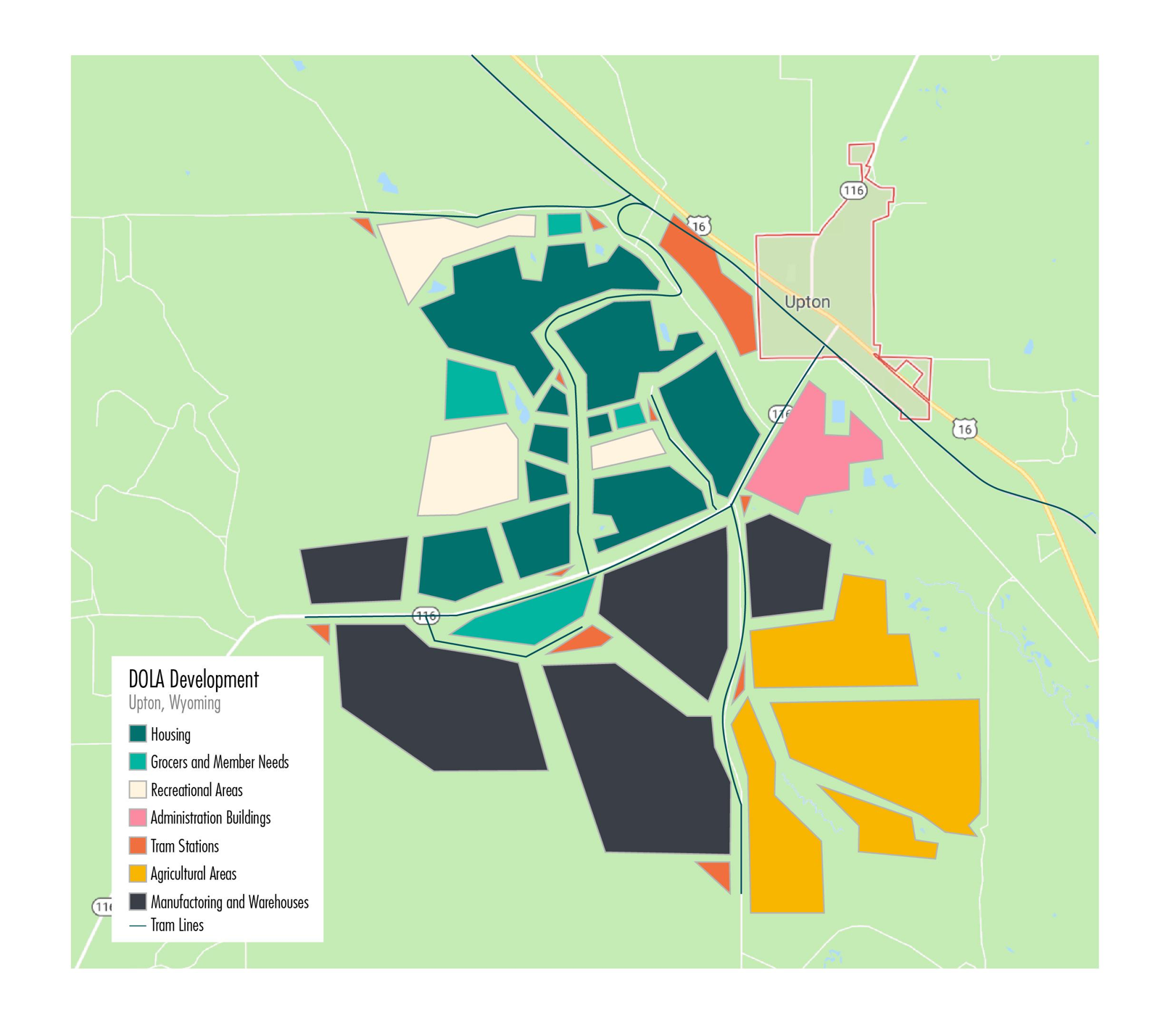
Above: For the third project on Speculative Design, Josh Hutchison (BFA ‘20) produced artifacts from a provocative and ambiguously dystopian (or utopian?) future in which Amazon has partnered with governments around the world to create privatized communities that house displaced persons, outcasts, refugees, and otherwise abandoned people (hence the name for the project, DOLA). While it sounds benevolent, there is, of course, a catch. In exchange for housing, food, and the provisioning of nearly every need imaginable, individuals in the DOLA communities would work for Amazon, for free. In Josh’s final presentation, he explained the way in which individuals would be assigned jobs within DOLA communities, the way the provisioning of housing would work, the way the DOLA communities would begin and the order of operations for growing the community and adding more residents and occupations/industries, and the myriad advantages for Amazon, effectively at this stage a logistics company, in having a community of individuals on whom it can test every facet of its business, from shipping to transit to healthcare.
Josh decided on a series of “beta-testing” locations for the project based on an in-depth research process that analyzed land usage and public policies in the various countries in which each DOLA would be located. Josh also analyzed the financial feasibility and potential financial benefits for Amazon and declared that it would be a very successful venture should Amazon pursue it. His final presentation was effectively a pitch for the project, which was both inspiring and deeply disturbing.
Josh decided on a series of “beta-testing” locations for the project based on an in-depth research process that analyzed land usage and public policies in the various countries in which each DOLA would be located. Josh also analyzed the financial feasibility and potential financial benefits for Amazon and declared that it would be a very successful venture should Amazon pursue it. His final presentation was effectively a pitch for the project, which was both inspiring and deeply disturbing.
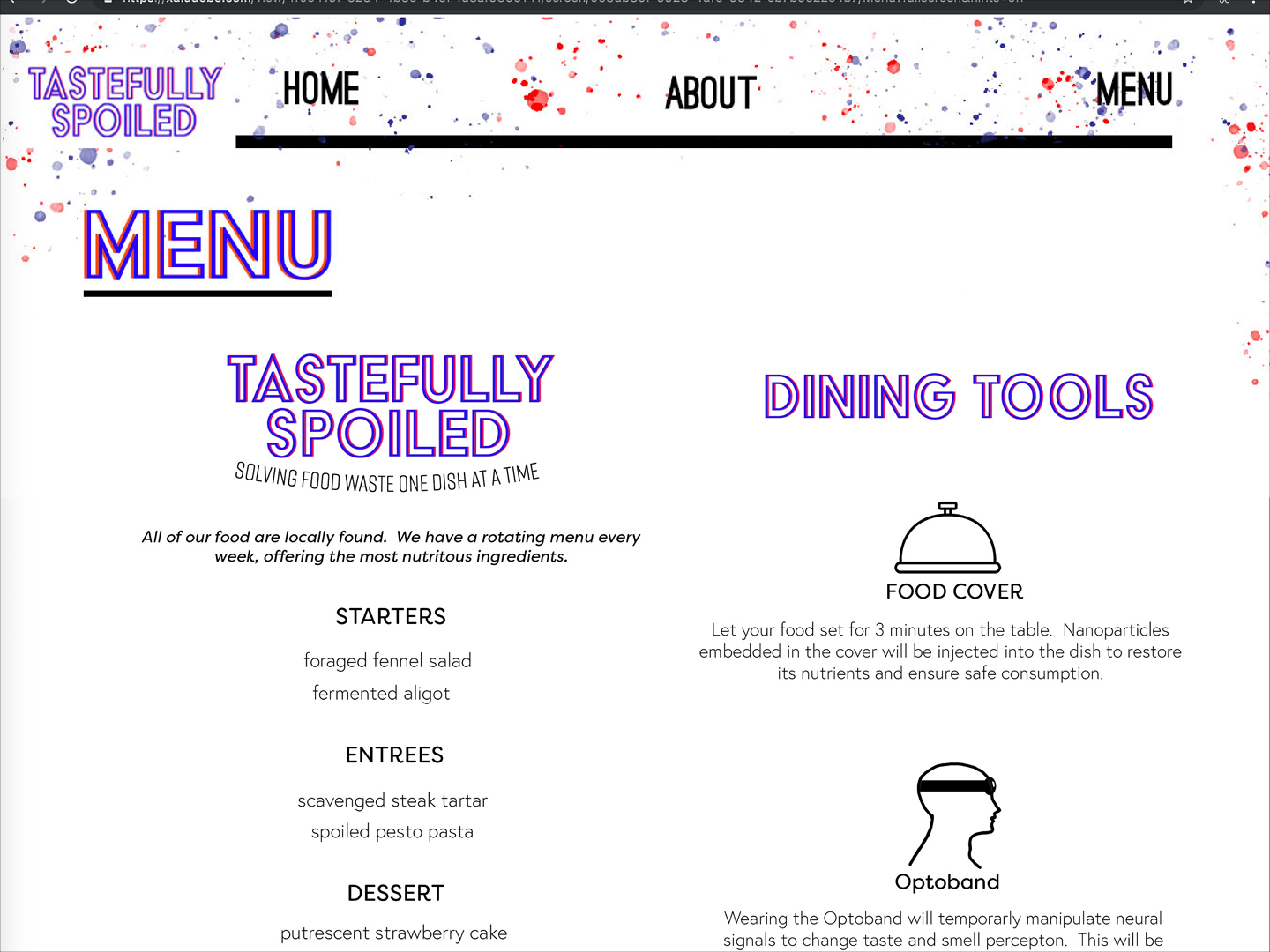
Above: Liz Vangyi produced a fascinating project about the future of food waste. She was interested in what happens as the global population increases and food becomes, relative to population, scarcer. She suggested that one of the root causes of food scarcity was actually food waste. Instead of focusing on futures in which food production would be augmented through technological or other means, Liz chose to focus on recuperating food that had been wasted by turning it into a luxury dining experience with emergent technologies. Her speculative project, called Tastefully Spoiled, proposed a future in which, “by using nanotechnology and optogenetics, we can bring nutritional value to food and make it safe to eat again.” Tastefully Spoiled is thus “a speculative dining experience of eating food waste with special tools.”